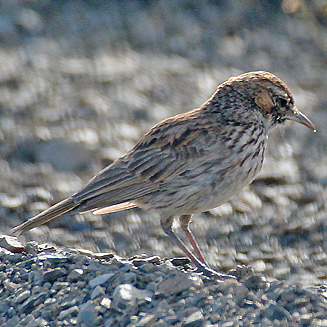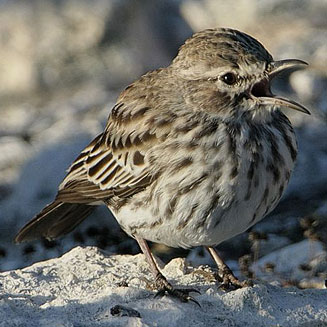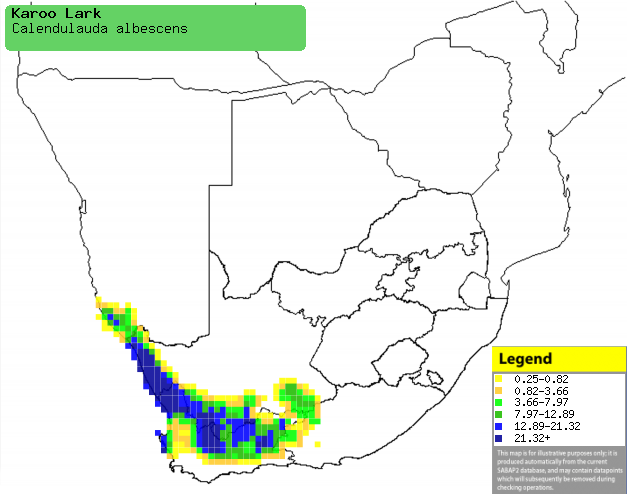|
Calendulauda albescens (Karoo lark)
[= Mirafra albescens]
Karoolewerik [Afrikaans]; Alouette du Karroo [French]; Karrulerche
[German]; Cotovia do Karoo [Portuguese]
Life
> Eukaryotes >
Opisthokonta
> Metazoa (animals) >
Bilateria >
Deuterostomia > Chordata >
Craniata > Vertebrata (vertebrates) > Gnathostomata (jawed
vertebrates) > Teleostomi (teleost fish) > Osteichthyes (bony fish) > Class:
Sarcopterygii (lobe-finned
fish) > Stegocephalia (terrestrial
vertebrates) > Tetrapoda
(four-legged vertebrates) > Reptiliomorpha > Amniota >
Reptilia (reptiles) >
Romeriida > Diapsida > Archosauromorpha > Archosauria >
Dinosauria
(dinosaurs) > Saurischia > Theropoda (bipedal predatory dinosaurs) >
Coelurosauria > Maniraptora > Aves
(birds) >
Order: Passeriformes > Family: Alaudidae
> Genus: Calendulauda
 |
 |
|
Karoo lark, South Africa. [photo
Jim Scarff
©] |
Karoo lark, South Africa, West Coast National
Park, South Africa. [photo Trevor Hardaker ©] |
Distribution and habitat
Endemic to South Africa, occurring from the western side of
the Eastern Cape to the Western and Northern Cape. It generally prefers
shrubland with soft, sandy soils, such as Karoo, sandplain Fynbos and strandveld.
|
 |
|
Distribution of Karoo lark in southern Africa,
based on statistical smoothing of the records from first SA Bird Atlas
Project (©
Animal Demography unit, University of
Cape Town; smoothing by Birgit Erni and Francesca Little). Colours range
from dark blue (most common) through to yellow (least common).
See here for the latest distribution
from the SABAP2. |
Food
It eats a variety of invertebrates and grass seeds, doing
its foraging on the ground, plucking food items from the bases of grass tufts
and shrubs. The following food items have been recorded
in its diet:
- Invertebrates
-
termites
- Hodotermes mossambicus (Northern harvester termite)
- Microhodotermes viator (Southern harvester termite)
- Nemopteridae (thread-wing lacewings)
-
mantids
-
Orthoptera (grasshoppers)
- Coleoptera
(beetles and weevils)
-
Hemiptera (bugs)
- leafhoppers and sapsuckers (Cicadelloidae)
- Formicidae (ants)
- Messor
- Monomorium
- Pheidole
- Tetramorium
- Crematogaster
- Acontholepis
- fly larvae (Diptera)
- snails
-
spiders
- Seeds
- Grasses
- Centropodia glauca
- Eragrostis
- Stipagrostis
- Cladoraphis spinosa (Spiny love grass)
- Shrubs
- Aizoon
- Aridaria
- Augea capensis (Bobbejaankos)
- Hermannia
- Lotononis
- Plexipus
- Protoasparagus
- Psilocaulon
- Requernia sphaerosperma
- Sphalmanthus
- Forbs
- Atriplex
- Amaranthus
- Chenopodium
- Dimorphotheca
- Galenia
- Indigofera
- Limeum
- Polygonum
- Talinum
- Tetragonia echinata (Kinkelbos)
- Tribulus terrestris (Dubbeltjie)
- Fruit of honey-thorn (Lycium)
Breeding
- The nest is mainly built by the female, consisting of a cup covered by a a
half dome, built of dry grass, strips of Milkweed (Asclepias buchenaviana)
bark, thin twigs and occasionally leaves. It is typically placed in a scrape
or hollow in the ground, often at the base of a grass tuft or shrub.
- Egg-laying season is from July-November, although in particularly dry
years it may not breed at all.
- It lays 2-3, rarely 4 eggs, which are white and blotched with brown and
grey.
- The chicks are fed by both parents on a diet of invertebrates, leaving
the nest before they are able to fly.
Threats
Not threatened.
References
-
Hockey PAR, Dean WRJ and Ryan PG 2005. Roberts
- Birds of southern Africa, VIIth ed. The Trustees of the John Voelcker
Bird Book Fund, Cape Town.
|
